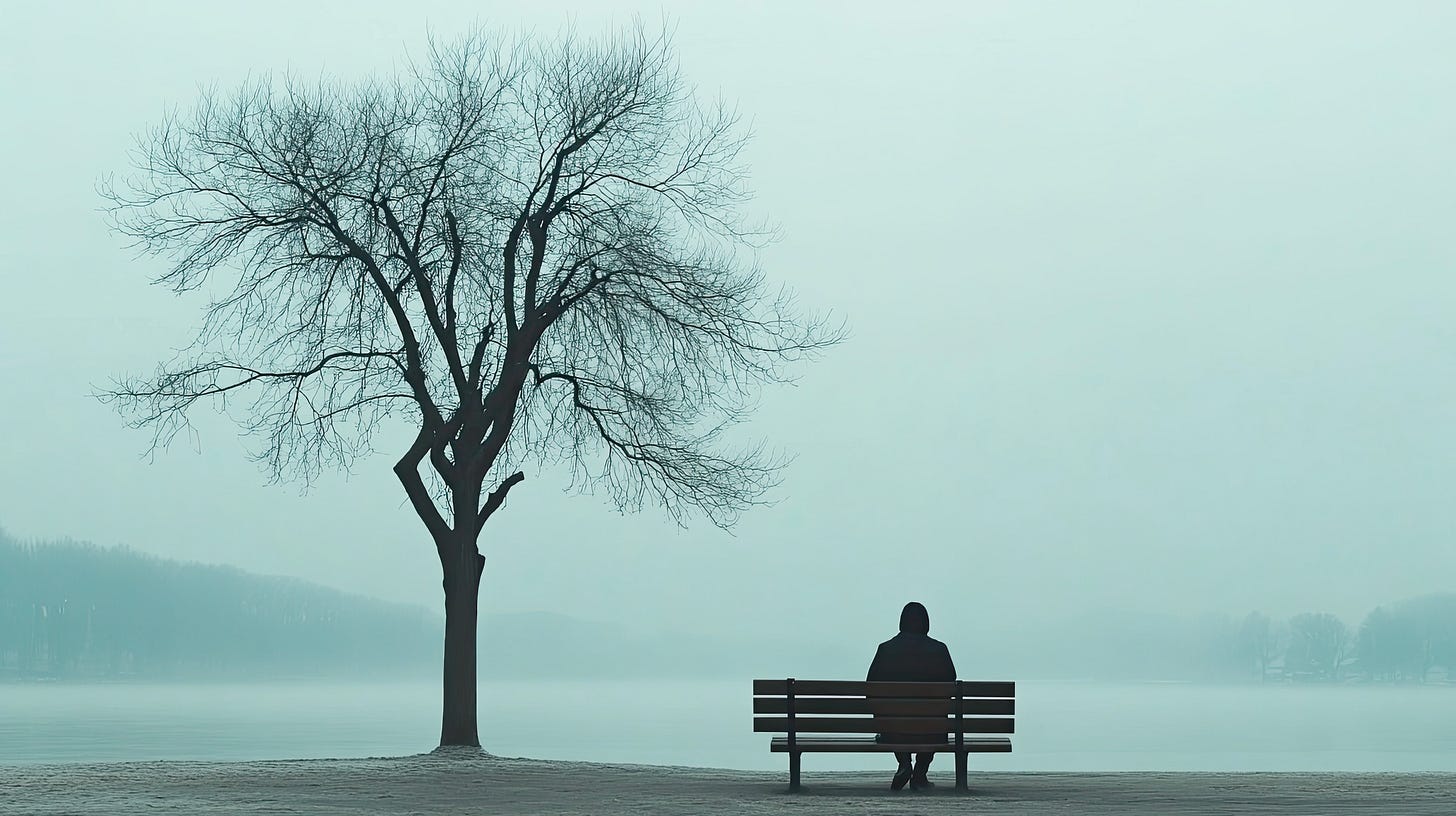The Alchemy of the Broken-Open Heart
Violence is what happens when we don’t know what else to do with our suffering...
A disciple asks the rebbe: “Why does Torah tell us to ‘place these words upon your hearts’? Why does it not tell us to place these holy words in our hearts?” The rebbe answers: “It is because as we are, our hearts are closed, and we cannot place the holy words in our hearts. So we place them on top of our hearts. And there they stay until, one day, the heart breaks and the words fall in.” —Hasidic Tale
I. Heartbreak comes with the territory called being human. When trust is betrayed, when what gave life meaning fails us, when a dream drifts out of reach, a devastating disease strikes, or someone precious to us dies, our hearts break.
What shall we do with our pain? How might we hold it and work with it? Is it possible to turn heartbreak toward new life? Our answers to those questions are critical because violence is what happens when we don't know what else to do with our suffering.
Violence isn’t limited to doing physical harm. We do violence every time we violate the sanctity of the human self, ours or another's. Sometimes we try to numb our pain in ways that diminish us—we plunge into nonstop work, surround ourselves with noise and frenzy, or turn to substance abuse. Sometimes we visit violence upon others, as if causing them pain would mitigate our own—racism, sexism and homophobia are among the outcomes of this brutal strategy.
It's the brittle heart that breaks apart, explodes into a thousand shards, and often gets thrown like a grenade at the ostensible source of its pain. But there’s another kind of heart, a supple heart, that can break open, not apart, giving us greater capacity to love and generate new life.
II. The life-giving alchemy of the broken-open heart is not a figment of my imagination—I see it all the time. At age 86, I know so many people who've suffered the loss of the most important person in their lives.
At first, they descend into grief, certain that life will never again be worth living. But slowly they emerge from the dark aware that their hearts have grown larger, not smaller. Instead of becoming bitter, resentful and withdrawn, they've become more generous and engaged—not in spite of their pain but because of it. Suffering has opened their hearts and made them more understanding of others, more grateful for the gifts of life, even when things get tough.
Are there ways to help the heart grow supple—to prepare it as a marathoner readies her muscles—making it more likely to expand than shatter when major heartbreak hits? My own practice, always imperfect, is to embrace life's little deaths and joys as they happen, instead of blowing by them in pursuit of my self-important agenda.
I stretch my heart when I take time to learn from a painful critique of my work, or from my own failure to live up to the standards I proclaim. I stretch it when I pause to give thanks for the passing kindness of a stranger, or revel in the infectious giggle of a toddler as I “hide” behind my hands, then pop out.
When I take all of it in, the darkness and the light—take it in mindfully, with full focus on the here and now—it helps make my heart supple enough to absorb and transform whatever life may bring.
III. Heartbreak can make us or break us in politics as well as our personal lives. Today, our democracy is imperiled due, in part, to a cascading sequence of heartbreaking events since the turn of the century: Sept. 11, 2001 when we were attacked by international terrorists. COVID-19, which left social polarization in its wake. January 6, 2021, when we were attacked by domestic terrorists. Sharp increases in wealth and income inequality. The rise of MAGA with its disdain for diversity, education, science, the rule of law, and democracy itself.
MAGA is Exhibit A of the wreckage that can be wrought by a political movement that taps into the destructive power of the broken-apart heart—a movement that gives people permission to hurl heart-grenades at whomever they blame for their pain. Who better to lead the charge than a man who’s long been motivated by a primal need for revenge against those who have “wronged” him, rather than by a desire to serve the common good, a man who will never understand that he’s been prosecuted for his crimes not persecuted for his beliefs?
Many who follow this man have their own grievances. He has convinced them that relief will come when their chosen scapegoats (e.g., immigrants) hurt as much as they do. His most visceral appeals to his base prove the point: “I am your warrior, I am your judge. And for all those who have been wronged, I am your avenger.” In the MAGA ideology, to quote Adam Serwer, “the cruelty is the point.”
IV. Is there a political equivalent to the broken-open heart, a political response to pain that says, “The suffering stops here, where it can be transformed”? If the lives of Sojourner Truth, Gandhi, Dorothy Day, Martin Luther King, Jr., Thich Nhat Hanh and John Lewis mean anything, the answer is yes. It’s called nonviolence.
Nonviolence has nothing to do with lying down and taking it. Based on the belief that withdrawing consent from unlawful power will weaken it, nonviolence calls us, to quote John Lewis, to “make good trouble.” Actions such as civil disobedience may put us at risk, but they can transform the world in ways violence never can.
My name for the space in which we must act is “the tragic gap”—the gap between what is and what could be, a gap built into the nature of reality that is inherently heartbreaking. On one side of the gap are the harsh realities of the world around us, with more kinds of suffering than we can name. On the other side are the possibilities we’ve seen with our own eyes, ways of being here for each other that give us a glimpse of MLK’s dream of the Beloved Community.
In an effort to avoid the tensions that break our hearts, we too often flip out on one side or the other of the tragic gap. Yield to what the world calls “reality,” and we end up as cynics who care only about our own fates. Disappear into dreamy fantasies about “possibility,” and we end up as idealists who float above the fray.
Cynicism and idealism sound like polar opposites, but they have the same effect: they take us out of the action and leave us on the sidelines of history. Our calling is to keep standing and acting in the tragic gap where history is made, putting one foot in front of the other in the long, slow walk toward a better world.
V. John Lewis knew all about that long, slow walk. In 2011, I was privileged to spend three days following him on the annual Civil Rights Pilgrimage across Alabama. On the third day, we marked the 46th anniversary of Bloody Sunday by marching across Selma’s Edmund Pettus Bridge with Lewis in the lead again at age 71, just he was at age 25 in 1965.
John Lewis knew what it meant to stand and act in the tragic gap. He never stopped putting one foot in front of the other, even when he was pushed back. He never faltered in his commitment to love, truth and justice, or in his faith that nonviolence was the only road to that end.
He understood something essential for all who want to walk this road: short-term effectiveness is not the standard to which we must hold ourselves, because the tragic gap will always be with us. What matters is that we remain faithful—faithful to our own gifts, faithful to the human needs that lie within our reach, and faithful to those moments when our gifts might help meet one of those needs.
I began this essay with an Hasidic tale about holy words being laid on our hearts so they can help make our hearts supple when heartbreak hits. This is how John Lewis was formed from his earliest days as the child of sharecroppers in Pike County, Alabama. The words of his family’s Christian faith were there when he needed them, helping his heart grow large enough to embrace the suffering of a nation, making him the living embodiment of a path toward healing.
There is another rabbinical teaching that shines a light on this path, a teaching that John Lewis would surely want us to lay upon our hearts: “It is not your responsibility to finish the work, but neither are you free to desist from it.” All that is asked of us is that we stay faithful to the vision of a destination we will never reach.
[My 10 books are HERE and HERE. A pamphlet-length essay titled “The Politics of the Brokenhearted” can be downloaded free from the Fetzer Institute HERE. The Center for Courage & Renewal is HERE. I post on Substack once a week as time and energy allow. Free as well as paid subscriptions are welcome, and all subscribers will always have access to everything I post.]





“I didn’t go to the Rabbi to hear him read from the Torah. I went to watch him tie his shoes.”
I come here to your posts to watch you tie your shoes Mr. Palmer. It seems every day I forget how to tie my own so I need an Elder Sage to remind me how to do it with wisdom, grace, and compassion. From this post, I’m ready to tie my shoes for today.
This truly touched my heart. I asked the Divine for guidance this morning and your post is my answer. Blessings and Health,
Debbie